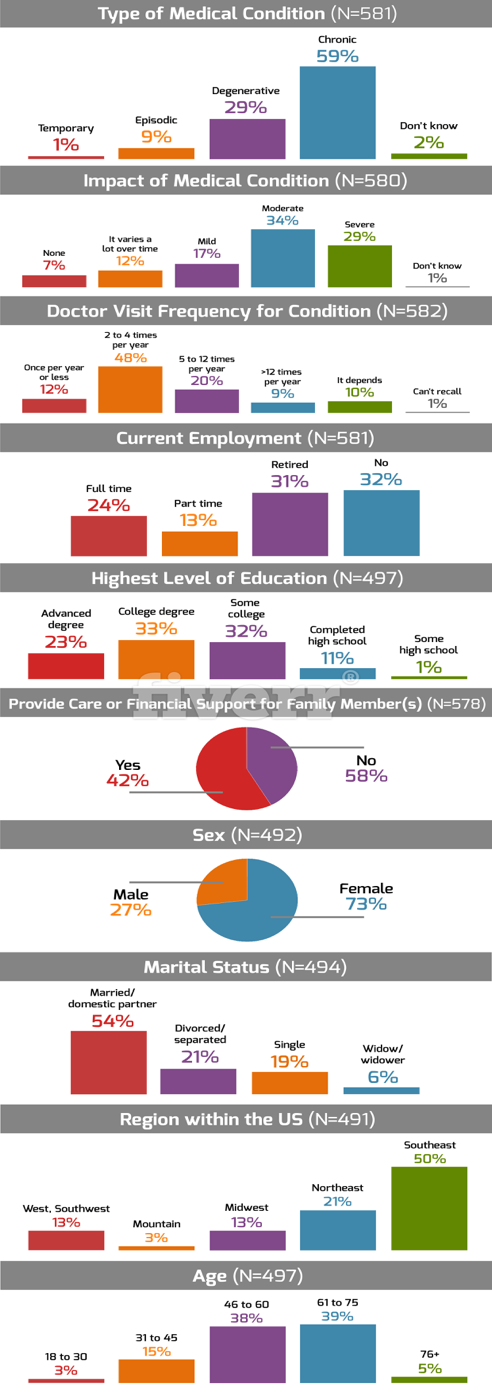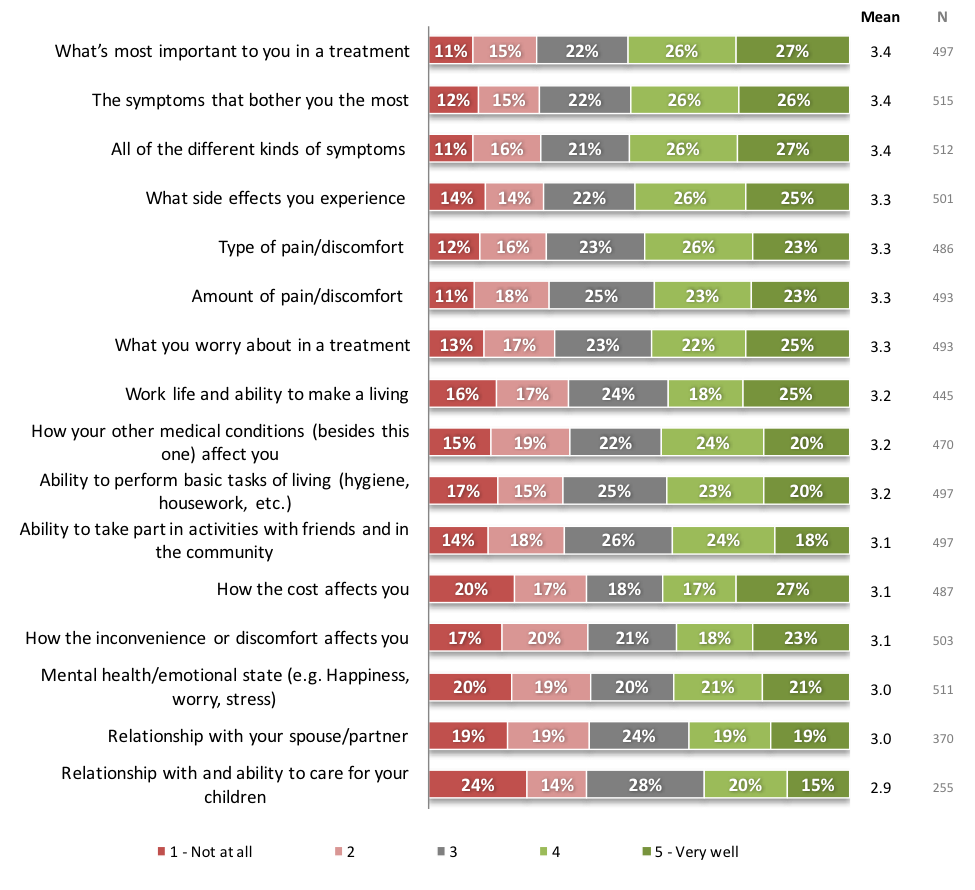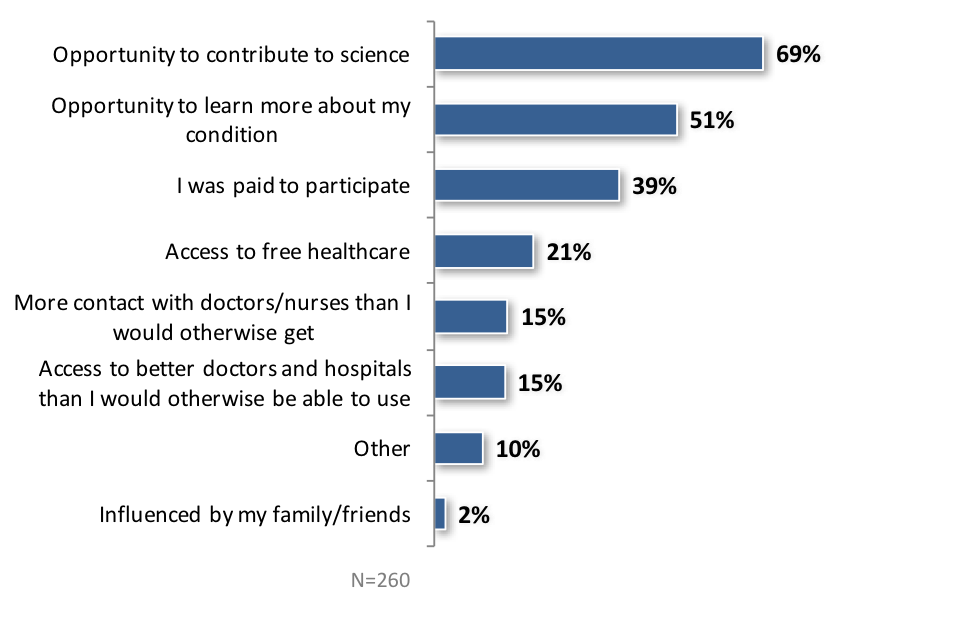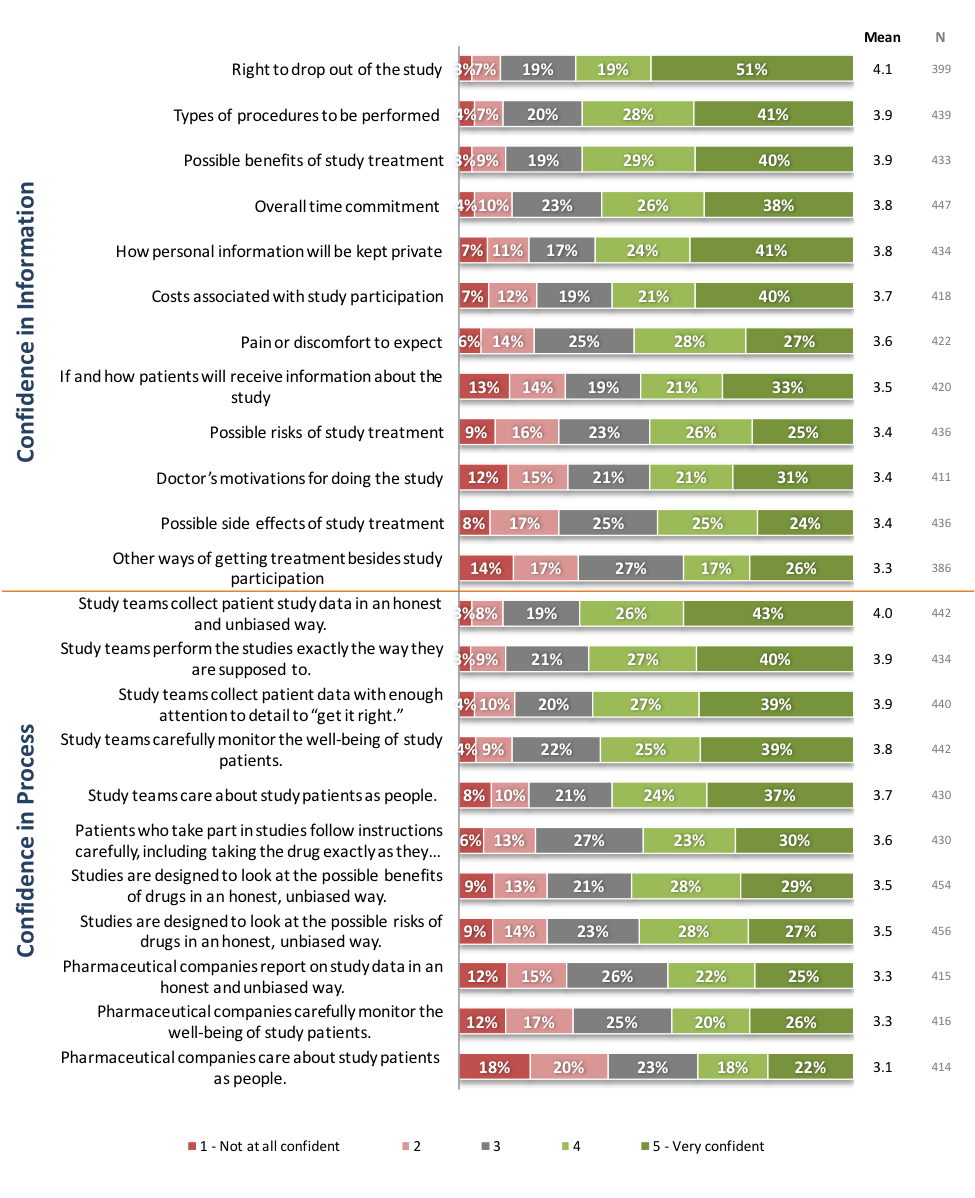Bridging the Gap for Better Patient Engagement
A survey from the Avoca Group examines issues related to quality of clinical trials and trial participation from the patients' view.

Recent innovations in technology and information flow have created a population of patients that is active in, and has high expectations of, their healthcare and treatment choices. This shift in the marketplace requires that key stakeholders in the clinical trial process understand the perceptions and motivations of their newly empowered customers. It is to aid this understanding that the Avoca Quality Consortium (AQC) commissioned a patient survey as part of its ongoing commitment to transform clinical trials. The overarching objective of the survey was to identify actions that pharmaceutical companies, CROs, and study teams might take to positively influence clinical trial participation and impressions of the clinical trial experience, and to increase the relevance of clinical trial results to patients.
Traditionally, clinical development teams seeking to understand patient experiences and motivations have relied heavily upon healthcare professionals as proxies for the patients themselves. Healthcare providers have partnered with clinical development teams both to define what represent clinically meaningful outcomes, and to address drivers of patient participation and retention in clinical trials. At present, however, the sufficiency of this approach is being questioned.1,2 With the advent of the internet and social media, researchers now have an unprecedented level of direct access to the patient “voice,” and gaps between perceptions of the patient experience that have developed through the traditional model, and what we are hearing from patients directly, have been revealed. Hence, one of the objectives of the survey was to evaluate the extent to which patients perceive that their medical care providers understand the patient experience, and to understand how this may vary across patients with different types of illnesses and different demographic characteristics.
Despite increased levels of patient interest in treatment options, appreciation of clinical trials as a viable care alternative remains limited.3 The factors that drive patients’ decisions to enroll and remain in clinical trials play a key role in decisions not only about protocol design, but also about site selection, expectations of and training for site staff, technologies employed, information provided, etc., and thus are important for industry professionals to understand. For this reason, another key objective of AQC’s 2016 Patient Survey was to understand how patients view clinical trial participation: how they feel about the “quality” and value of clinical research, their confidence level in the clinical trial process and the information with which clinical trial patients are provided, and why they would or would not choose to participate in a clinical trial. Again, the survey sought to understand not just “general” patient perceptions in this area, but also the disease and demographic characteristics that drive differences across patient subsets.
This article presents the results of the Avoca Quality Consortium’s patient survey. This was a standalone survey, but incorporated parallels with questions that had been asked in other AQC and Avoca surveys of sponsors and clinical survey providers, to allow for comparisons where applicable. After the research plan and survey were reviewed and granted exemption status by Western IRB, potential participants were contacted by email using email addresses from the PMG Research, PLM (PatientsLikeMe), CISCRP (Center for Information and Study on Clinical Research Participation), and Avoca Quality Consortium databases, all of which are “opt in” databases comprised of individuals who have elected to receive email contacts from the relevant organizations. The introductory emails notified prospective participants about the survey, and included a description of its objectives, the types of participants being recruited (adults who self-identify as patients with any medical condition), and the fact that the survey was anonymous. In the email, potential participants were provided with a link to The Avoca Group’s web-based survey platform, where they were first directed to an Informed Consent page providing information about the study, asked to verify that they were at least 18 years of age and US Citizens, and then given the option to consent or decline. Those who both qualified and consented were then directed to a webpage where they could complete the survey anonymously.
The survey itself was comprised of: non-identifying demographic questions; questions about perceptions of how well medical service providers, research professionals, and regulators understand their conditions; and questions about confidence in the clinical trial process. Approximately 10-20 minutes were required for completion, and no question required a response to continue with the survey. All statistical analyses were performed using JMP software.
Five hundred and eighty-two patients participated. Participants represented those with chronic (59%), degenerative (29%), episodic (9%), and temporary (1%) conditions, as well as a few who didn’t know how to designate their conditions (Figure 1). The impact of these patients’ conditions on their day-to-day lives ranged from virtually none (7%) to severe (29%), with medical care required between once or less per year (12%) and more than 12 times per year (10%). Thirty-seven percent were employed; 56% held at least a college degree; and 42% supported families. Most were female (73%), married (54%), and/or over the age of 45 (82%).Forty-five percent of patient participants had participated in a clinical trial in the past.
Figure 1. Demographics

Understanding by Providers
On average, survey participants did not feel that their healthcare providers had a very good understanding of what it was like to be a patient with their condition. Mean “perceived understanding” ratings ranged from only 2.9 to 3.4 on a scale of 1 (no perceived understanding at all) to 5 (perceived to understand “very well”), and for each question, between 26% and 39% of patients gave a rating of 1 or 2 (Figure 2).

Figure 2. Patient perceptions of how well their healthcare providers understand what it’s like to be a patient with their condition
As can be seen from the distributions of ratings given for each question, there was pronounced heterogeneity across patients in the extent to which they felt understood. Multivariate analyses that accounted for multiple disease and demographic characteristics at once were performed to better understand this heterogeneity. In these models, the strongest drivers of differences across patients were age group (patients aged 76+ generally felt the most understood by their providers, and those aged 31-45 the least), marital status (single and married patients generally felt the most understood, and divorced and widowed patients the least), and role (or not) in providing financial support or care for family members (providers generally felt less understood than non-providers). Disease characteristics (as depicted in Figure 1) and history of clinical trial participation had relatively little impact on these results (data available upon request).
Themes in patients’ open-ended explanations for their responses included: a perceived inability for anyone to understand the patient experience/pain/symptoms; lack of vocabulary or self-tracking; perception that medical providers don’t have time or don’t concern themselves with understanding; and “partitioning” of patient care across providers so that each only understands “a piece” of the patient; Interestingly, 28% stated that there were aspects of their conditions and treatments that they elected not to share with their health care practitioners at all. This purposeful withholding of information by patients was often done out of embarrassment, for financial reasons, or to influence access to continued treatment.
Clinical Trial Participation
Forty-five percent of survey participants had participated in a clinical trial in the past. Within this group, the most common reason for participation was the opportunity to contribute to science, followed by the opportunity to learn more about their conditions, and then by financial considerations (respondents could select as many of the offered reasons as they felt relevant, as well as offer “other” responses; Figure 3). Sixty-five percent reported feeling more educated and involved in their overall health as a result of their participation.

Figure 3. Reasons for clinical trial participation, among those with participation history
The type and impact of medical condition (categories as depicted in Figure 1) did not have a significant impact on the top few reasons for clinical trial participation. As for the less frequently endorsed reasons, patients with chronic and degenerative conditions were more likely than those with episodic conditions to be motivated by additional contact with and access to better medical professionals (additional contact: 17%-18% vs. 0%; access to better professionals: 13%-16% vs 4%), and generally endorsed more reasons for trial participation overall. Patients with mild disease impacts were more likely to be influenced by access to free healthcare than were those with more serious conditions (28% vs. 14%-18%), and those with no disease impact were more likely to be influenced by payment (50% vs. 33%-39%).
Demographic characteristics also had some influence on the reasons for clinical trial participation. For older patients (76+), the additional expected contact with doctors and nurses was a key reason for participation (36% vs. 12%-17% for other age groups), whereas for younger patients, access to better doctors and hospitals was more likely to be key (17%-22% for ages 31-60 vs. 7%-14% for ages 61+). Females on average endorsed more reasons for participating in clinical trials than did males, though the overall pattern of top reasons was the same.
Sixty-seven percent of survey participants would recommend clinical trial participation to a loved one or friend; 29% were unsure; and 4% would not. Among those who would recommend participation, responses carried themes of consideration of risks vs. benefits, of the institutions at which the studies are being performed, and of a wish to “do good” for society. Among those who would not, responses generally reflected a distrust of the clinical research industry, or concerns about the possibility of receiving ineffective treatment or placebo.
Confidence in the Clinical Trial Process
With respect to confidence in the information provided to prospective clinical trial participants, most of those surveyed had at least a fair level of confidence that trial participants are fully and honestly informed (Figure 4). Participants were most likely to be confident in information provided about the right to withdraw, procedures, and possible benefits, and were most skeptical about information relating to treatment alternatives, risks and side effects, and doctors’ motivations.
With respect to confidence in the quality of the clinical trial process overall, most participants again had at least a fair level of confidence in the compliance, caring, and ethics of the site study teams and patients involved in clinical trials; however, many were skeptical about the honesty of pharmaceutical companies and about the extent to which they cared about study patients (Figure 4).

Figure 4. Patient confidence in clinical trial information and process
In both cases, the distributions reflected considerable response heterogeneity, particularly for areas that were rated on average most poorly. Interestingly, in multivariate models, the most frequent drivers of differences across patients with respect to confidence in the information provided appeared to be a history of clinical trial participation (positive impact on confidence), disease impact (highest confidence in those with mild disease), and marital status (divorced people demonstrate less confidence); all other disease and demographic characteristics had relatively little impact on the results once the effects of these three were accounted for. The strongest drivers of differences across patients with respect to confidence in clinical trial compliance and ethics appeared to be a history of clinical trial participation (positive impact on confidence), educational level (highest confidence in those with least education), and marital status (divorce associated with less confidence); all other disease and demographic characteristics were again of relatively low impact.
Common themes in patient comments to this section included: the positive impacts of including patients in the design of both protocols and operational approaches to study execution; demonstrating respect and caring of patients in all aspects of execution including compensation; and exercising transparency at every level. Business concerns both positively and negatively impacted confidence levels: some patients were skeptical of the ethics of pharmaceutical companies given the large amounts of money involved in researching and selling therapeutics, while others saw the high stakes as providing assurance that maximum rigor would be applied. Regulatory requirements and a belief in human nature and professionalism further bolstered confidence, while media stories regarding litigation and drug recalls eroded it.
Overall, the results from this study lead to the clear conclusion that as an industry, we can do more, today, to impact both patients’ perceptions of clinical trial participation, and the relevance of our trial designs to patients’ personal experiences of their diseases. From basic training in mindsets for key stakeholders to incorporating the patient voice in the protocol design process, there is work to be done to move the needle on patient engagement. In fact, although at present it is still acceptable from a regulatory perspective to define the research questions to be addressed by protocols in traditional ways, the ability to obtain approval for and competitively market medical products will likely soon depend on incorporation of the patient perspective4. Moreover, in developing research questions, careful forethought must be given to whether each planned study offers opportunities for us to more fully understand, directly from our study patients, their experience of disease, and thus improve the quality of our future research.
References
1. Lowe, M., Blaser, D.A., Cone, L., Arcona, S., Ko, J., Sasane, R., and Wicks, P. 2016. Increasing Patient Involvement in Drug Development. Value Health 19(6): 869-878.
2. Hoo, A., Anderson, J., Boutin, M. et al. Partnering with patients in the development and lifestyle of medicines: a call for action. 2015. Ther Innov Regul Sci. 49: 929–939.
3. Shen, J., Buechler, A., Byrne, J., Hecht, J., James, J., and Pancratz, B. 2015. Clinical Research Participation as a Care Option: Driving patient experience and satisfaction. PMG Research White paper, https://www.pmg-research.com/Portals/0/Clinical%20Research%20as%20a%20Care%20Option_PMG%20Research%20White%20Paper%20Web2.pdf
4. Parmar, A. 2016. How FDA is driving interest in patient engagement. Med City News, Sept 8, 2016.
Denise Calaprice, PhD, is a Senior Consultant, with The Avoca Group; Jennifer Byrne is Chief Executive Officer of PMG Research, and Jeremy Gilbert isVice President, Product and Strategy, PatientsLikeMe.
Patient and Site Personnel Perceptions of Retail Pharmacy Involvement in Clinical Research
March 7th 2024Despite industry-wide excitement over the involvement of retail pharmacies in clinical research, there is little information currently available on how retail pharmacies are perceived by investigative sites and patients.